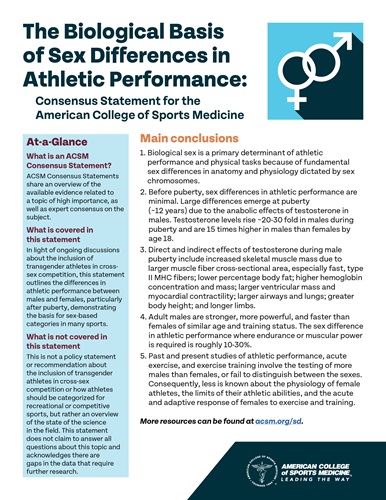by
Greg Margason
| Sep 29, 2023

ACSM has released a new pronouncement, “
The Biological Basis of Sex Differences in Athletic Performance: A Consensus Statement for the American College of Sports Medicine,” published in ACSM’s
Translational Journal of Sports Medicine.
What does that mean?
First, let’s talk about what ACSM pronouncements are, then about the specific type of pronouncement this is, which will give us insight into how and why it was developed.
ACSM pronouncements are official statements demonstrating the organization’s stance or position on a particular subject, for which ACSM’s Pronouncements Committee screens and selects a team of experts to research said subject and author a subsequent pronouncement. Then, (a) the pronouncement is rigorously reviewed by the Pronouncements Committee, (b) the ACSM journal the pronouncement is to be published in administers several rounds of external peer review, and (c) the ACSM Administrative Council and Board of Trustees grant final approval.
Such pronouncements come in a number of distinct forms, all with their own unique development and review processes: position stands, umbrella reviews, expert consensus statements, contemporary issues, and calls to action. You can learn more about each of these pronouncement types on the ACSM website.
This current pronouncement is an ACSM Expert Consensus Statement. These statements represent a combination of the available evidence on a particular subject and, as the name suggests, a consensus of expert opinion. ACSM reserves such pronouncements for subjects of high importance or wide-ranging impact. However, these pronouncements do not necessarily indicate policy recommendations.
“The Biological Basis of Sex Differences in Athletic Performance: A Consensus Statement for the American College of Sports Medicine” aims, as the name likewise conveys, to share the most up-to-date knowledge available and an expert consensus about the biological reasons behind sex differences in athletic performance — particularly as athletic governing bodies debate policies regarding the inclusion of transgender athletes in cross-sex competition. This latter point is important to ACSM because the organization is dedicated to encouraging safe physical activity and sports participation for all people. Again, however, the statement’s purpose is not to make policy recommendations but rather survey the field to see what information might be available for, or necessary to include in, such a discussion.
What does this statement include?
 The statement’s findings show that differences in performance between males and females are largely driven by males’ far greater production of testosterone beginning at puberty — roughly 12 years of age. In fact, by age 18, males on average have 15 times more testosterone in their bodies than females. Thus, adult males are faster, stronger and produce more power than females of approximately the same age and training. In athletic events that showcase or otherwise require aerobic capacity or muscle power, males outperform females by 10-30%. (Though this consensus statement does briefly cover some of the biological differences in children, its focus is almost entirely on adults.)
The statement’s findings show that differences in performance between males and females are largely driven by males’ far greater production of testosterone beginning at puberty — roughly 12 years of age. In fact, by age 18, males on average have 15 times more testosterone in their bodies than females. Thus, adult males are faster, stronger and produce more power than females of approximately the same age and training. In athletic events that showcase or otherwise require aerobic capacity or muscle power, males outperform females by 10-30%. (Though this consensus statement does briefly cover some of the biological differences in children, its focus is almost entirely on adults.)
The statement’s authors also note, however, that there is far less evidence about athletic performance in adult females than one might expect or, rather, hope for. Historically, and even today, much of the field has focused on the exercise physiology and performance of males, and more research centered on females could provide much-needed, actionable data from this relatively neglected population. The implications for the health and performance of female athletes could be profound, even beyond athletic competition. Such research would also be particularly timely as females enter, in increasing numbers, traditionally male professions that require physical prowess, including the military, law enforcement and firefighting.
Regarding transgender issues, ACSM plans to publish two further pronouncements on the subject, “Clinical Care (health/performance) Issues of Transgender Athletes” and “Call to Action on the Need for More Research.” Both of these papers are currently in development.
The authors point out that there are still many gaps in the current research regarding sex differences in athletic performance. They note particular opportunities for studies examining exercise performance and adaptations related to short- and long-term exercise, as well as exploration of different training and rehabilitation modalities for males and females.
For additional resources on the consensus statement, please visit acsm.org/sd.
Correction Note (Published 10/6/23)
The Consensus Statement Writing Group has corrected two errors identified in the original pronouncement published on Sept. 29. Both errors were found in the same statement in Box 1: Definitions.
Original Statement
Two percent of humans are intersex, harboring both male and female reproductive organs, and are reproductively fertile.
Corrected Statement
Differences/disorders of sex development (DSD) are rare conditions in which the development of chromosomal, gonadal, and anatomic sex is atypical (outside the binary of male/female).
Rationale for Corrections
This statement erroneously shared that “Two percent of humans are intersex..” The two percent figure represents the broadest range of conditions characterized by genital, reproductive, hormonal or sex chromosome differences, and includes many conditions that are not widely considered to be classified as DSD/intersex traits. The prevalence is much lower with narrower definitions of DSD/intersex. As a result, the two percent figure has been removed, the phrase corrected and the language is now consistent with the original corresponding sentence in the consensus statement itself (See page 19, under the heading “Hormonal Disorders (PCOS, DSD)”).
Additionally, the sentence incorrectly stated that individuals with DSD are “reproductively fertile.” Because some with DSD do experience infertility, the phrase was removed completely.
The Translational Journal of the American College of Sports Medicine will release an errata as soon as possible in order to ensure the published record is as accurate as possible.
Medicine & Science in Sports & Exercise will incorporate the corrected language into the final version of the consensus statement, which will appear in its December 2023 issue.